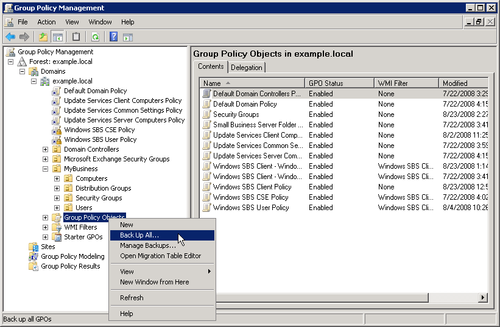1. Backing Up a Group Policy Object
A valuable feature, new in the Group Policy Management Console,
is the ability to back up and restore GPOs. Include regular backup of all GPOs as part of your
overall planning-for-disaster strategy. To back up a GPO, follow these
steps:
Open the Group Policy Management Console. In the console
tree, navigate to Group Policy Objects in the domain that contains
the GPO to be backed up.
To back up a single GPO, right-click the GPO and select
Back Up.
To back up all GPOs in the domain, right-click Group
Policy Objects and select Back Up All. (See Figure 1.)

In the Back Up Group Policy Object dialog box, type the path
to the backup location and then click Back Up.
After the operation completes, click OK.
Note:
Because the only reason to back up GPOs—or anything else, for that matter—is to
protect data that might have to be restored one day, be sure that
the backup folder is secure and can be accessed only by authorized
administrators.
2. Restoring a Group Policy Object
You can easily restore GPOs that have been backed up. If you
back up all the GPOs in a container, you can restore all of them, some
of them, or one at a time.
To restore backed-up GPOs, complete these steps:
Select Group Policy from the Administrative Tools
menu.
In the console tree, navigate to Group Policy
Objects.
To restore a previous version of an existing GPO or to
restore a deleted GPO, right-click Group Policy Objects and select
Manage Backups.
In the Manage Backups dialog box, select the GPO to restore
and click Restore.
When you have a lot of GPOs to sort through, select the check box that
allows you to display only the latest versions of the backed-up GPOs.
If you’re unsure of which GPO to restore, highlight them one at a time
and click View Settings.